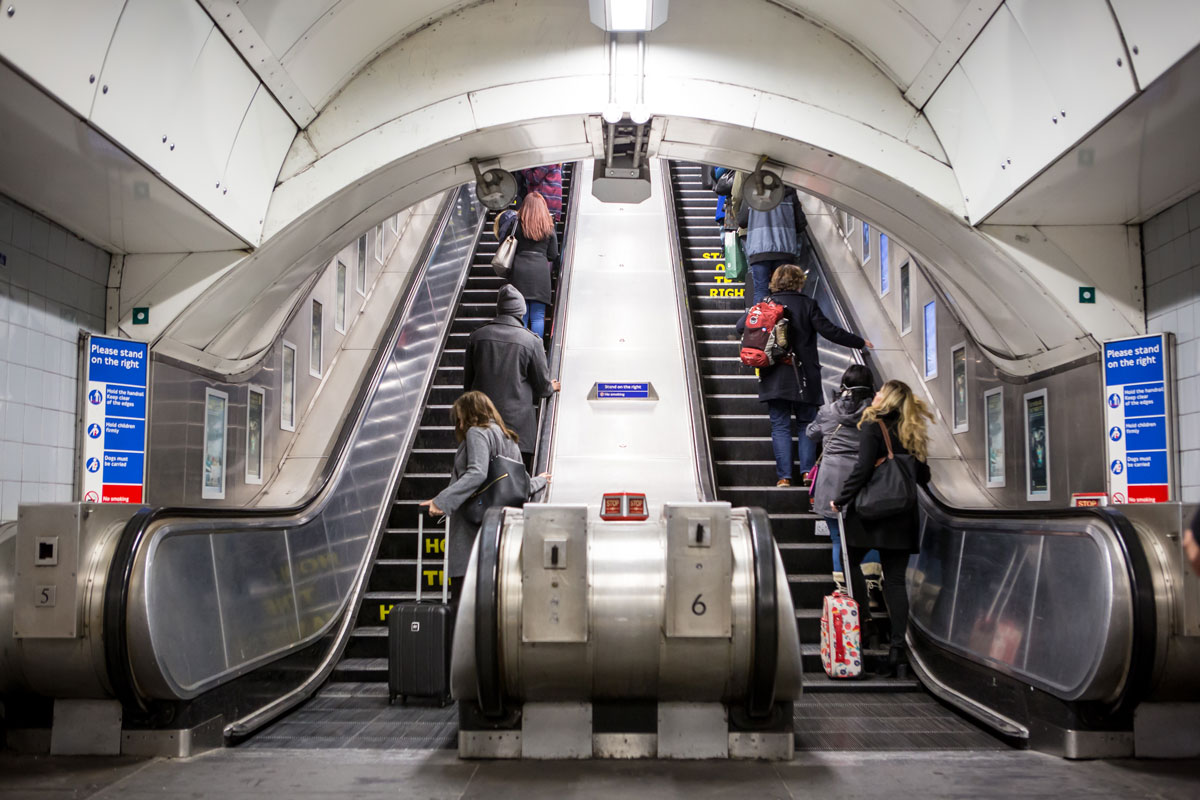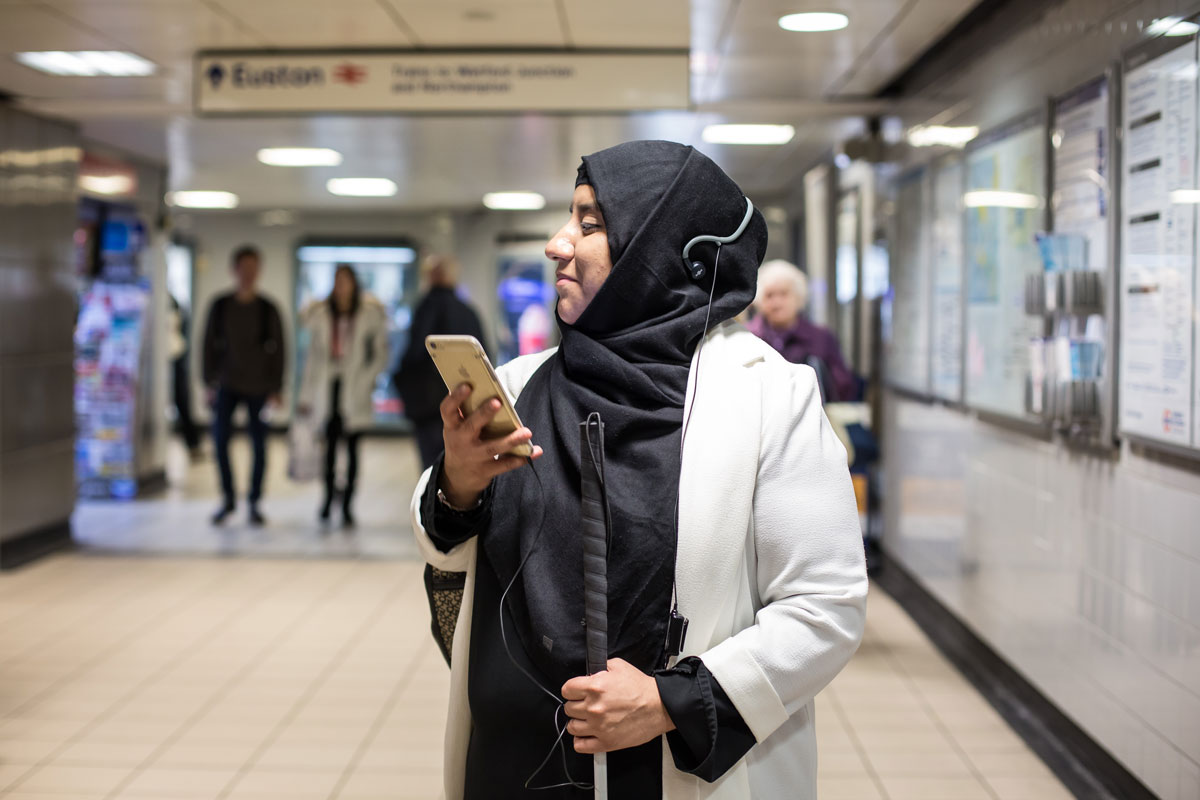Creating a Sonic Identity for Wayfindr

This guest blog is written by Henry Daw, an experienced sound designer and audio branding consultant, based in London. He previously worked for 13 years as an in-house sound designer, for Nokia and later Microsoft, where he composed for billions of devices worldwide whilst overseeing Nokia’s world-renowned audio brand for over a decade. Henry has also worked extensively on user interfaces, working closely with UX, UI, interaction, and motion designers, whilst bringing sound to the forefront of the design process. Following on from Henry’s work for the Microsoft Cities Unlocked project, which aims at providing a navigational aid for the blind using binaural audio, he became involved with Wayfindr late last year.
The cities of today are notoriously hectic, full of potential hazards, and noisy; from the seemingly non-stop traffic, to the everyday clatter of pedestrians. The majority of people are able to confidently navigate their way through this sonic urban jungle; but what if you had very limited vision or couldn’t see at all? For the 285 million vision impaired people around the world, this is an everyday challenge. Research has suggested that many vision impaired people avoid this by staying at home or sticking to a route they are familiar with. The Wayfindr Open Standard aims to address this by ensuring a consistent navigational experience using clear auditory cues. Late last year, after being put in contact with Umesh Pandya. I was thrilled to join this fantastic project, providing sound design support whilst laying the foundations for a unique sonic identity. I’d like to share with you how that sonic identity came together.
Wayfindr Sound Needs
The first task was to establish the immediate sound needs for the Wayfindr Open Standard. The voice instructions would be native to the OS, and thus out of our control, but immediately prior to each voice instruction there would be a short notification alert. In the majority of cases it would be a short general notification alert, except when you’re about to hear the last voice instruction on your scheduled journey. In which case you will hear the journey completed notification alert. In early trials of Wayfindr there was just one placeholder sound, to be used in all instances, but feedback suggested an additional sound for journey’s end was needed. Additional sounds could potentially be added to the Wayfindr Open Standard later, as it is developed, but for the first draft release of the Open Standard there would only be the two sounds, and together with the close relationship between them this would form the core audio brand.
For the early concept work I focused on the general notification alert. The existing placeholder sound, which Umesh had grabbed from a free online resource, was used as the basis for a lot of the work. The existing sound was based on a synthetic marimba instrument – it was a harsh tone that lacked character, yet during the trials it was shown to be working – functionally – quite well.
Sound Design Principles
I felt the new sounds wouldn’t need to be radically different from what we already had. Functionality was after all the key factor, so it was a matter of re-designing the sounds to reflect the user-driven design principles and brand character of the Wayfindr experience. The Wayfindr brand was yet to be properly developed (Moving Brands would work on the visual and physical branding later on) but, for my work, I highlighted some key words that I felt the sounds needed to reflect:
Functional
Confident
Humble
Modern
Friendly
Another major consideration was the fact that the sounds were created as part of an Open Standard – sounds that were freely available for use by third parties and developers. After initially exploring the option of retaining a marimba tonality but making it more natural and organic, my attention began to turn towards a more neutral tonality. I focused on a synthetically pure sound, a sound that didn’t necessarily evoke any associations, something that would invariably be the case when using an ‘instrument’ such as a marimba. We would of course be encouraging other brands to use the Wayfindr sounds, so anything too bold or ‘characterful’ had the potential for branding conflicts. A more neutral tone to the sounds and they should fit seamlessly into any third party service.
Coherent Pair
In the next iteration of sound design work, I focused on the notification alert for “Journey Completed”. Both the general, and journey completed, notification alerts would be created as a coherent pair. Sounds that will typically be similar in tonality or instrumentation (sharing design principles that contribute to a consistent UX), but varied enough in their form to communicate a specific function. Paired sounds are common practise, especially in the context of smartphones – renowned examples include the “Listen” and “Confirmation” sounds used for the personal assistant “Siri” in Apple iOS, or the similarly paired “Google Now” sounds. Other examples of paired UI sounds typically include an on and off, lock and unlock, and connect and disconnect pairing. For the paired Wayfindr sounds, the general notification alert would consist of two notes, and the journey end of three notes. This relationship between the two alerts would form a key part of the DNA, which later on would feed into the work by Moving Brands.

Audio Branding
When Moving Brands started their work with Wayfindr, we had some workshops around the visual and physical aspects of the brand. We also talked about ideas around a “sound mnemonic” (or audio logo) to use with a logo animation. I was cautious against creating a completely new sound, for which it’s primary role was likely to be in marketing. To me it didn’t really feel aligned to the “user-driven” principles that Wayfindr aspires to. However, if we created an ‘additional’ sound that simply consisted of the two notification sounds together, as one sound playing after each other, this would link well to the actual user experience, and also strengthen the brand recognition. In the future there is also potential for it to become some kind of accreditation sound – for example, you walk into a shopping centre and the first sound you hear will be the “accreditation sound” so that you know it is Wayfindr supported.
User Testing
After discussions with the Wayfindr team and Moving Brands, we narrowed down our notification pairings to two different concepts, which we would then test and compare. For these elements, including the audio logo, Moving Brands arranged a sit-down session with users to talk about the brand. To test the notification alerts, we had a user testing session in Old Street Underground station. The testing brought up some useful insights such as a need to differentiate the Wayfindr notification alerts from the native phone sounds. Although users preferences and tastes were different, both concepts were received favourably, and reactions to the additional “journey completed” alert were positive. After discussions with Moving Brands and the Wayfindr team, the final concept was selected.
Final Sounds
Functionally, the selected pairing worked well – it was sufficiently alerting, yet subtle enough to not cause undue alarm. The pairing between the sounds also linked perfectly, and just felt right, with the identically pitched two notes for the general notification and the rising-pitched three notes for the journey completed notification. As the Wayfindr brand took on a really fresh and exciting look and feel, the match-up between the sounds and the logo animation also began to take shape. After some subtle editing to ensure the two sounds linked seamlessly, the end result was a logo animation that we were all happy with. My final task (prior to the first draft release of the Open Standard) was to ensure the Wayfindr Guidelines Document accurately reflected my work with the notification alerts. To assist any third parties or developers who use the Open Standard, it’s vital that we clearly communicate the principles and thinking behind the notification sounds – communication is obviously one of the key factors behind the successful adoption of an Open Standard.
You can hear the General, and Journey Complete notification alerts below.
Video of the Wayfindr logo, along with the notification alerts.
Just the Beginning
Wayfindr is very much at the beginning of its journey, and I find it tremendously exciting to envisage how far it will go. Just imagine a future urban environment that was fully accessible to the vision impaired, based on a consistent audio navigation experience. I’m humbled and privileged to be involved, especially when I reflect on how important sound is to the everyday life of someone who cannot see. Using the Wayfindr platform and community, there is a fantastic opportunity to foster new ideas using sound, and collectively work towards developing the Standard. I’d welcome anyone who has an interest in audio-based navigation to get in touch and join the community. Ideas we’ve already discussed for the future involve the addition of a ‘warning alert’, specific categorized sounds, or even enhanced auditory experiences such as subtle changes in audio feedback as your journey progresses. As we are now though, it feels as if we have built a solid core audio brand and UX for Wayfindr going forward. The Wayfindr audio DNA is born, now let’s make it grow.
You can explore the Open Standard here.
Our team combines the digital product and user centred design expertise of ustwo, with the Royal London Society for Blind People’s 175 years of experience working with blind people.